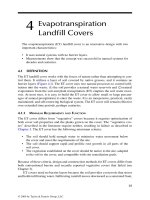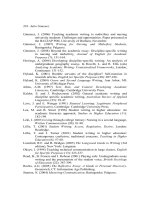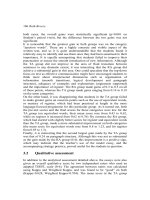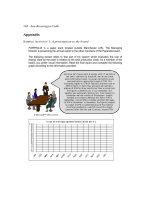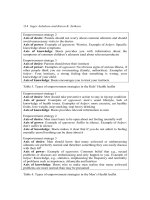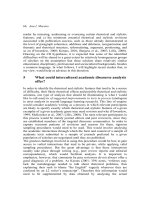English for Professional and Academic Purposes phần 4 doc
Bạn đang xem bản rút gọn của tài liệu. Xem và tải ngay bản đầy đủ của tài liệu tại đây (872.92 KB, 24 trang )
Ana I. Moreno 66
reader by misusing, underusing or overusing certain rhetorical and stylistic
features; and c) the minimum essential rhetorical and stylistic revisions
associated with publication success, such as those already demonstrated at
the level of paragraph coherence, additions and deletions, reorganization and
thematic and rhetorical structure, reformulating, argument, positioning, and
so on (Flowerdew, 2000; Kerans, 2001; Burgess et al., 2005; Lillis, 2008).
Drawing on the CR hypothesis, it is expected that some of the identified
difficulties will be shared to a great extent by relatively homogeneous groups
of scholars on the assumption that these scholars share relatively similar
educational, disciplinary, professional and sociocultural backgrounds, besides
a common language. In what follows, I will highlight recent studies that, in
my view, would help us advance in this direction.
5 What could intercultural academic discourse analysis
offer?
In order to identify the rhetorical and stylistic features that tend to be a source
of difficulty, their likely rhetorical effects and possible rhetorical and stylistic
solutions, one type of analysis that should be illuminating is what I would
like to call analysis of suggested improvements to texts in process (analogous
to error analysis in second language learning research). This line of enquiry
would consider academic writing as a process in which relevant participants
are likely to specify exactly which rhetorical and stylistic features of a given
exemplar of a given academic genre may need revision and why (Flowerdew,
1999; McKercher et al., 2007; Lillis, 2008). The most relevant participants in
this process would be mainly journal editors and peer reviewers, since they
are established members of the targeted discourse communities. In order to
capture recurrent patterns of revisions and reasons for them, rigorous
sampling procedures would need to be used. This would involve analysing
the academic interactions through which the form and content of a sample of
academic texts submitted to a sample of journals preferred by a given
population of scholars are negotiated until they are published.
The greatest challenge involved in using this procedure would be how to gain
access to verbal interactions that tend to be private, while applying valid
sampling procedures. But the great advantage is that these interactions
usually take place through writing (e.g., peer review reports and editorial
correspondence), which would facilitate analysis. It is important to
emphasize, however, that comments by peer reviewers do not always offer a
good diagnosis of a problem. As Kerans (2001: 339) notes, “referees may
lack the metalanguage needed to talk about rhetorical problems, thus
explaining their rush to blame “the English” vaguely whenever they are
confused by an L2 writer’s manuscript”. Therefore this information would
need to be supplemented by data obtained by analysing the actual
Researching into English for research publication purposes 67
manuscripts and their subsequent revisions towards publication (e.g., Burgess
et al., 2005). Relevant information could also be obtained by means of
qualitative methods (e.g., focus groups and talk-around-text interviews)
(Flowerdew, 2002; Lillis and Curry, 2006; Lillis, 2008) with a view to
triangulating the research and accessing peer reviewers’ and end readers’
perceptions of quality in academic writing.
Given the focus of this type of studies on text interactions between
participants from diverse linguistic, cognitive and sociocultural backgrounds,
they could be situated in the realm of intercultural rhetoric research (Connor,
2004a, 2008). Connor’s distinction between contrastive and intercultural
rhetoric draws on Sarangi’s (1995: 22) distinction, according to which
“‘cross-cultural’ attends to abstract entities across cultural borders, while
‘intercultural’ deals with the analysis of an actual encounter between two
participants who represent different linguistic and cultural backgrounds”.
Since the studies I envision would look at actual encounters for negotiating
the meaning and form of academic texts between academics with diverse
linguistic and cultural backgrounds, I would like to further characterize them
as intercultural academic discourse analysis (IADA).
6 Final remarks: On bridging the research-teaching
gap in ERPP
My major concern in this paper has been to suggest ways in which future
cross-cultural studies could obtain increasingly comparable, reliable and
explanatory findings that could be ever more useful to ERPP courses
designed for NNES scholars in countries where English is not the medium of
communication. To illustrate my proposal, I have given examples of research
relevant to the Spanish context, but the suggested approach could also be
applicable to research into ERPP undertaken in relation to other languages
used in similar contexts. The research design I have proposed would, among
other things, aim to establish the rhetorical and stylistic features that are
typically rejected when NNES scholars attempt to publish their research
internationally. This would allow intercultural researchers to set up an
inventory of rhetorical and stylistic difficulties whose possible origin could
be investigated by follow-up cross-cultural studies, thus helping to bridge the
gap between intercultural and cross-cultural discourse analysis.
The major drawback of this multiple-approach design is that it would take
years to obtain visible results and, as is well known, genres are dynamic
constructs. Therefore, it would be essential for large teams of researchers to
be able to rapidly coordinate their efforts around common pedagogical
objectives. The great advantage would be that, on the basis of results
obtained in this way, more “pedagogically-primed” resources (Swales, 2002:
155) could be designed for relatively homogenous groups of scholars in
Ana I. Moreno 68
terms of their cultural, linguistic and disciplinary backgrounds. These could
offer scholars and their instructors, mentors or other writing facilitators: a)
insights into the difficulties likely to be encountered in the publication
process; b) reliable explanations for some of them; c) more reliable
information about the consequences of not changing rhetorical and stylistic
habits; and d) a clearer picture of viable rhetorical and stylistic solutions on
which they could base choices. In classroom teaching, instructors could select
or adapt the most relevant activities for a given group of participants in a
given ERPP course on the basis of information gathered from specific pre-
course needs analysis.
References
Ayers, G. (2007) The evolutionary nature of genre: An investigation of the
short texts accompanying research articles in the scientific journal
Nature, English for Specific Purposes (27) 1: 22.41.
Burgess, S. (2002) Packed houses and intimate gatherings: Audience and
rhetorical structure. In Flowerdew, J. and C.N. Candlin (eds)
Academic Discourse, London: Longman: 197-215.
Burgess, S., M.C. Fumero Pérez and A. Díaz Galán (2005) Mismatches and
missed opportunities? A case study of a non-English speaking
background research writer. In Carretero, M., L. Hidalgo Downing,
J. Lavid, E. Martínez Caro, J. Neff, S. Pérez de Ayala and E.
Sánchez-Pardo (eds) A Pleasure of Life in Words: A Festschrift for
Angela Downing Madrid: Dptos. de Filología Inglesa I y II. Facultad
de Filología. Universidad Complutense de Madrid: 283-304.
Cargill, M. and S. Burgess (2008) Introduction to special issue: English for
research publication purposes, Journal of English for Academic
Purposes (7) 2: 75-76.
Connor, U. (2004a) Introduction. Contrastive rhetoric: Recent developments
and relevance for English for academic purposes, Journal of English
for Academic Purposes (3) 4: 271-276.
Connor, U. (2004b) Intercultural rhetoric research: Beyond texts, Journal of
English for Academic Purposes (3) 4: 291-304.
Connor, U. (2008) Mapping multidimensional aspects of research. In Connor,
U., E. Nagelhout and W. Rozycki (eds) Contrastive Rhetoric:
Reaching to Intercultural Rhetoric, Amsterdam: John Benjamins:
299-315.
Connor, U. and A.I. Moreno (2005) Tertium comparationis: A vital
component in contrastive rhetoric research. In Bruthiaux, P., D.
Atkinson, W.G. Egginton, W. Grabe and V. Ramanathan (eds)
Directions in Applied Linguistics: Essays in Honor of Robert B.
Kaplan Clevendon, England: Multilingual Matters: 153-167.
Researching into English for research publication purposes 69
Curry, M.J. and T. Lillis (2004) Multilingual scholars and the imperative to
publish in English: Negotiating interests, demands, and rewards,
TESOL Quarterly (38) 4: 663-688.
Dafouz, E. and B. Núñez (2009) CLIL in higher education: Devising a new
learning landscape. In Dafouz, E. and M.C. Guerrini (eds) CLIL
across Educational Levels: Experiences from Primary, Secondary
and Tertiary Contexts, London/Madrid: Richmond Publishing: 101-
112.
Flowerdew, J. (1999) Problems in writing for scholarly publication in
English: The case of Hong Kong, Journal of Second Language
Writing (8): 243-264.
Flowerdew, J. (2002) Ethnographically inspired approaches to the study of
academic discourse. In Flowerdew, J. (ed) Academic Discourse,
Harlow, UK: Pearson Education: 235-253.
Flowerdew, L. (2002) Corpus-based analysis in EAP. In Flowerdew, J. (ed),
Academic Discourse, Harlow, UK: Pearson Education: 95-114.
Fortanet Gómez, I., J.C. Palmer Silveira, J. Piqué Angordans, S. Posteguillo
Gómez and J.F. Coll García (2002) Cómo Escribir un Artículo de
Investigación en Inglés, Madrid: Alianza.
Gómez I., M.T. Fernández, M. Bordons, F. Morillo and B. González-Albo
(2007) La actividad científica del CSIC a través del Web of Science,
Estudio Bibliométrico del Período 2000-2006. Scientific Report,
<
Gómez, I., R. Sancho, M. Bordons and M.T. Fernández (2006) La I+D en
España a través de sus publicaciones y patentes. In Sebastián, J. and
E. Muñoz (eds) Radiografía de la Investigación Pública en España,
Madrid: Biblioteca Nueva: 275-302.
Harwood, N. and G. Hadley (2004) Demystifying institutional practices:
critical pragmatism and the teaching of academic writing, English
for Specific Purposes (23) 4: 355-377.
Hyland, K. (2000) Disciplinary Discourses, London: Longman.
Kaplan, R.B. (1966) Cultural thought patterns in inter-cultural education,
Language Learning (16): 1-20.
Kerans, M.E. (2001) Eliciting substantive revision of manuscripts for peer
review. In Muñoz, C. (ed) Trabajos en Lingüística Aplicada,
Barcelona: Univerbook: 339-348.
Lillis, T. (2008) Ethnography as method, methodology and ‘deep theorising’:
Closing the gap between text and context in academic writing
research, Written Communication (25) 3: 353-388.
Lillis, T. and M.J. Curry (2006) Professional academic writing by
multilingual scholars: Interactions with literacy brokers in the
production of English medium texts, Written Communication (23) 1:
3-35.
Ana I. Moreno 70
Lorés-Sanz, R. (2006) ‘I will argue that’: First person pronouns as
metadiscoursal devices in RA abstracts in English and Spanish, ESP
across Cultures (4) 3: 23-40.
Lorés-Sanz, R. (2009) Different worlds, different audiences: A contrastive
analysis of research article abstracts. In Suomela-Salmi, E. and F.
Dervin (eds) Cross-cultural and Cross-linguistic Perspectives on
Academic Discourse (Vol. 2), Amsterdam/Philadelphia: John
Benjamins: 187-198.
Martín-Martín, P. (2003) A genre analysis of English and Spanish research
paper abstracts in experimental social sciences, English for Specific
Purposes (22): 25-43.
McKercher, B., R. Law, K. Weber, H. Song and C. Hsu (2007) Why referees
reject manuscripts?, Journal of Hospitality & Tourism Research (31)
4: 455-470.
Moreno, A.I. (1998) The explicit signalling of premise-conclusion sequences
in research articles: A contrastive framework, Text (18) 4: 545-585.
Moreno, A.I. (2004). Retrospective labelling in premise-conclusion metatext:
An English-Spanish contrastive study of research articles on
business and economics, Journal of English for Academic Purposes
(3) 4: 321-339.
Moreno, A.I. (2008) The importance of comparable corpora in cross-cultural
studies. In Connor U., E. Nagelhout and W. Rozycki (eds)
Contrastive Rhetoric: Reaching to Intercultural Rhetoric,
Amsterdam: John Benjamins: 25-41.
Moreno, A.I. and L. Suárez (2008a) A study of critical attitude across English
and Spanish academic book reviews, Journal of English for
Academic Purposes (7) 1: 15-26.
Moreno, A.I. and L. Suárez (2008b) A framework for comparing evaluation
resources across academic texts, Text & Talk (28) 6: 749-769.
Moreno, A.I. and L. Suárez (2009) Academic book reviews in English and
Spanish: critical comments and rhetorical structure. In Hyland, K.
and G. Diani (eds) Academic Evaluation: Review Genres in
University Settings, Basingstoke, UK: Palgrave-Macmillan: 161-
178.
Mur-Dueñas, P. (2007) A Contribution to the Intercultural Analysis of
Metadiscourse in Business Management Research Articles in
English and in Spanish: A Corpus-driven Approach. Unpublished
doctoral dissertation, Zaragoza: Universidad de Zaragoza.
Mur-Dueñas, P. (2008) Analysing engagement markers cross-culturally: The
case of English and Spanish business management research articles.
In Burgess, S. and P. Martín Martín (eds) English as an Additional
Language in Research Publication and Communication, Bern: Peter
Lang: 197-213.
Researching into English for research publication purposes 71
Mur-Dueñas, P. (2009) Citation in business management research articles: A
contrastive (English-Spanish) corpus-based analysis. In Suomela-
Salmi, E. and F. Dervin (ed) Cross-cultural and Cross-linguistic
Perspectives on Academic Discourse. Amsterdam: John Benjamins:
49-60.
Mur-Dueñas, P. and R. Lorés-Sanz (2009) Responding to Spanish academics’
needs to write in English: From research to the implementation of
academic writing workshops. Paper presented at the 27th AESLA
International Conference. Ways and Modes of Human
Communication, Ciudad Real, 26-28 March.
Pérez Ruiz, L. (1999) Análisis contrastivo de los resúmenes en inglés y
español en artículos publicados en el campo de la epidemiología,
ES: Revista de Filología Inglesa (22): 167-176.
Rey-Rocha, J., M.J. Martín-Sempere, L.M. Plaza, J.J. Ibáñez and I. Méndez
(1998) Changes on publishing behaviour in response to research
policy guidelines: The case of the Spanish Research Council in the
field of Agronomy, Scientometrics (41) 1: 101-111.
Salager-Meyer, F. (2006) From “Mr. Guthrie is profoundly mistaken ” to
“Our data do not seem to confirm the results of a previous study
on ”: A diachronic study of polemicity in academic writing (1810-
1995), Ibérica (1): 5-28.
Salager-Meyer, F., M.A. Alcaraz Ariza and N. Zambrano (2003) The
scimitar, the dagger and the glove: Intercultural differences in the
rhetoric of criticism in Spanish, French and English medical
discourse (1930-1995), English for Specific Purposes (22) 3: 223-
247.
Sarangi, S. (1995) Culture. In Verschueren, J., J. Östman and J. Blommaert
(eds) Handbook of Pragmatics, Philadelphia: John Benjamins: 1-30.
Swales, J.M. (1990) Genre Analysis: English in Academic and Research
Settings, Cambridge: Cambridge University Press.
Swales, J.M. (2002) Integrated and fragmented worlds: EAP materials and
corpus linguistics. In Flowerdew, J. (ed) Academic Discourse,
Harlow, UK: Pearson Education: 151-164.
Swales, J.M. (2004) Research Genres: Explorations and Applications,
Cambridge: Cambridge University Press.
Valero-Garcés, C. (1996) Contrastive ESP rhetoric: Metatext in Spanish-
English economics texts, English for Specific Purposes (15) 4: 279-
294.
Acknowledgments
I am really grateful to Margaret Cargill, Inmaculada Fortanet, Mary Ellen
Kerans and two anonymous reviewers for their useful remarks on previous
versions of the present paper.
Section II
Discourse analysis of
professional English
Research reports in academic and
industrial research
1
Philip Shaw
Many doctoral students at Swedish technical universities are so-called
industridoktorander who are seconded by their companies to study for an advanced
degree while employed by the company, and typically while working on research
topics which arise naturally out of their industrial work. They therefore have
experience of the genres and writing processes associated with in-company research
and development as well as those of academic research. This paper reports on
interviews based on text samples in which such doctoral students describe their
writing, its production conditions, and its audiences (and hence language choice).
The aim is examine their perceptions of the differences between the two writing
environments and the discourses which researchers use to discuss them.
Broadly it is concluded that the subjects perceive themselves as belonging
simultaneously to two discourse communities with rather different values. University
research reports are themselves exposed to competition for publication space and need
to stand on their own, while the internal reports are embedded in a network of telephone
and email communication and are written more for the record. Therefore the academic
reports need to be tightly focused, carefully written in the ‘empiricist repertoire’, and
explicitly meet the expectations of an international audience, while the company test
reports are merely raw material for use in inter-company competition, and therefore
must be inclusive, to some extent truthful in a ‘contingent repertoire’ and implicitly
refer to the shared company environment. However in-company attitudes to the written
product vary according to the discipline; archival material can be very valuable in some
areas and useless in other, fast changing, fields.
1 Introduction
The groups of genres called ‘report’ are extremely diverse (Ruiz-Garrido,
2006). They include genres written by learners like the lab report or book
report, business genres like the public annual report or the monthly project
report (House et al., 2003), and research genres like the technical report.
‘Report’ writing is a much demanded skill and teaching it is quite big
business.
The actual nature of any report of course depends on its place in the genre
assemblage (Spinuzzi, 2004) of a job and on its purpose, audience and topic.
However the various report genres typically have official names (Santini,
2008), and are relatively stable (Schryer, 1994) and visible, foregrounded for
their users. This means that they are much discussed, and to some extent sites
of struggle. Although writing takes up a great deal of engineers’ time, as an
1
This research was financed by the funds for my guest professorship at KTH, the Royal Institute
of Technology in Stockholm and a visit to the 4th International Symposium on Genre Studies
generously funded by KTH Language Unit and Stockholm University English Department.
Philip Shaw
76
activity it is not prominent in engineers’ image of their culture. Writing is not
mentioned in Kunda’s study of the subculture (1992), for example and
Artemeva et al. (1999: 303) say “these students usually bring with them a
resistance to the notion of engineering as a profession that requires literacy”.
Managers often say that their subordinates cannot write reports (Brammer
and Ervin, 1999; Gaboury, 1999), though this is such a universal complaint
that one may suspect that power plays a role, and dissatisfaction with
subordinates’ writing sometimes merely transfers the managers’ own
difficulties downwards. Another common complaint is that engineering
students do not write enough in their university education and that
universities should do more to train them (Wisler, 2008).
The diversity of the report group is, however, such that learner genres may
not be helpful antecedents (Devitt, 2007) for professional genres. For them to
be effective antecedent genres it would have to be the case that the objects of
“the learning activity in the school (the theories, laws, methods, tools, and
other artifacts of the profession) become ‘mediational means’ in the
workplace” (Le Maistre and Paré, 2004: 45, cited in Artemeva, 2007). That
is, things learned for their own sake in the classroom become available as
tools in the workplace. But this is not a simple transfer. Using workplace
genres is a matter of acquiring the identity of a workplace participant and
perceiving the conditions of production and power relations typical of this
environment. This may not be easy, since learner genres are very different in
this respect; their aim is to display knowledge and allow testing (Hållsten,
2008: 168).
In learner genres, power, knowledge of content and disciplinary values, and
communicative skill are all in the audience’s hands. The text is autonomous –
the teacher sits alone and grades, in engineering classes often with no
dialogue with the writer at all. The action intended – setting a grade – is
entirely in the hands of the knowledgeable, powerful and skilful partner. It is
thus not surprising that teachers emphasize the importance of meeting the
audience’s expectations.
In professional genres, power, knowledge and communicative skill are
distributed in varying proportions among the actors (Dias et al., 1999; Winsor
1999). When an expert writes a report for a manager, for example, the
knowledge and the power are broadly speaking on opposite sides.
Professional texts are embedded in a matrix of shared drafts, emails, phone
calls, chats, and the written product is rarely the sole bearer of its purpose.
The action intended by the text is complex, formed by the community in
which the document is written, and requires multiple decisions. This can
result in conflicts among actors. So engineers often fail to see the complexity
of the situation and focus on what they want to see done, leading to
managers’ complaints that they do not consider the reader enough.
Research reports in academic and industrial research
77
For example, Abbott and Eubanks (2005) found that academic writing
teachers based their judgements of text quality on general principles like
providing topic sentences, while practising engineers made similar
judgements but on the basis of “speculations about the particular context and
the effect the memo might have” (p. 201). Interestingly, Forey (2004) found
that people working in business paid more attention to the ideational than the
interpersonal features of a text and their primary concern was with clarity
rather than the hectoring tone which struck teachers. Teachers and (linguistic)
researchers may, says Forey, be overly sensitive to linguistic choices, or at
least may have a discourse for talking about texts which highlights these.
Parks (2001) found that nursing students were taught at college to write care
plans in an explicit way as if for public consumption, but once they were in
the community of practice they learned to write less explicitly, saving effort
and assuming shared knowledge. Here again there was conflict in the real-
world environment. Senior staff visualized a wider audience for the plans; the
more implicit versions were ‘bad habits’.
There has been much discussion of the workplace-classroom opposition
(Artemeva, 2007), but there is another interface between the academy and
industry which has had less attention, and that is in the area of research and
development. In the academy there is an organic progression from learner
tasks to research genres (essay/lab report Æ undergraduate thesis Æ
dissertation Æ article). In industry, research genres like technical reports are
part of a web of intertextually linked genres; the product of technical reports
goes into project progress reports and specifications, and these in turn lead
ultimately to marketing and sales documents. The research genres in industry
and academia themselves, however, may have identical types of content
(results of investigations) and broadly similar purposes (to inform interested
parties of these results). Understanding the differences which nevertheless
exist between the genres will, on a practical level, help us understand the
different requirements of the environments in which engineers are required to
write, and, on a theoretical level, provide insight into the relation of genre
and purpose (Askehave and Swales, 2001).
This paper reports an investigation into the relationship between academic
and industrial research reporting, as perceived by engineers working in both
fields simultaneously. At technical universities in Sweden there are PhD
students called industridoktorander, who have come back into academic
research after a period of work in industry. They are employed by a company
but working on an academic project. They typically spend three or four days
a week at the university and one or two in their company, even if they are
mainly working on their PhD project in both environments. They do not
teach and are not novice academics being drawn into that community of
practice. Their aim is rather to acquire expertise which will be valuable to
their company, but also of course to acquire academic accreditation for
Philip Shaw
78
themselves. So they are at the professional/research interface, with
experience of both environments.
The research questions asked in this paper concern research reports written
for the company and as part of doctoral studies (mainly published as
academic articles). The investigation views industrial research reports and
academic articles as related genres and aimed to identify shared perceptions
of the differences between them in terms of the classic genre characteristics
(Swales, 2004) of purpose, audience, and the style and form of the product
text.
The questions to which answers are sought are:
• How do research reports fit into the respective genre assemblages of
their environments?
• How are the reports perceived in terms of audience, status, language
choice (local language Swedish or international language English),
and rhetorical requirements?
2 Method and subjects
I contacted a convenience sample of 10 industridoktorander in the field of
vehicle engineering and arranged to interview them, four at their company
and six at what I will call the Technical Institute, a large and prestigious
engineering university in Sweden. Nine were men, one a woman and eight
came from one large Swedish-owned vehicle manufacturer, one from another
large US-owned manufacturer and one from a small vehicle engineering
company owned by UK financial interests. Nine were L1 speakers of
Swedish, one of German. They were at varying stages of their academic and
industrial careers, with from a few months to ten years’ employment in their
companies and from a few months to four years of doctoral work. All were
employed in research and development departments; the small company
specialised in this area. Their work in companies was typically not as
members of closely-knit project development teams, but (like Hållsten’s
informants (2008)) as experts on a particular narrow area, who might be
consulted and asked to carry out tests on prototypes or parts under
development by a number of such teams.
The interviews lasted between half an hour and forty-five minutes. I took
notes and recorded on an MP3 recorder. The interviews were semi-structured
– based on a schedule of questions (Appendix), all of which I obtained
answers to, but which I added to where appropriate. Five interviews were
conducted in Swedish and five in English, since all participants claimed they
were willing to use either language. In practice the company environment
encouraged the use of Swedish, the university that of English. All interviews
were conducted in the language I initiated them in (although I offered the
Research reports in academic and industrial research
79
choice), and it also seemed natural to me as an L1 English speaker to initiate
in English at the university and in Swedish at the company.
3 Results
3.1 Genre repertoire
The interview technique is clearly better for eliciting fairly formal written
genres than occluded or oral ones. It therefore produced something more like
a genre repertoire focussed in communicative named genres than a genre
ecology including all ephemera, self-directed notes, etc., (Spinuzzi, 2004;
Hållsten, 2008), which were doubtless very common. Subjects needed
prompting to elicit e-mail, telephone conversations, etc. The genres they
mentioned can be categorised as business, educational, and research. In the
first category most of them only perceived themselves as producing minutes
of meetings. Only the subject who worked in a small company produced a
full range of genres, including tenders, product documentation, etc.
Educational genres consisted of coursework assignments at the Royal
Institute – problem solutions and presentations, for example. Research genres
were produced in both environments. In the university they produced theses –
the licentiate waystage and the actual doctoral dissertation – conference
papers and journal articles. Most doctoral theses were, or were to be,
compilations of published articles with an introduction creating some sort of
unity, but even where the thesis was to be a monograph, conference papers
and articles played a large part in writing at the university. In the company,
research or testing work was reported in such genres as technical reports,
specifications, standards, technical requirements, system descriptions, and
again conference papers. Here I focus on technical reports and conference
papers in the company and articles and papers at the university.
3.2 Audience and place in the genre system
Published articles are in the public domain and open to all, indeed the number
of outside readers (citations) is a key metric of their success. By contrast
company research reports are normally private and in fact kept quite secret,
so that mere language researchers are not able even to see an example. This is
one aspect of the quite considerable generic differences encountered by
industridoktorander.
Interviewees noted that in the academy the final text is a primary means of
communication which is autonomous and must speak for itself. By contrast,
in industry by the time one writes the report one has already informed all
those who are primarily concerned orally or by email or a Powerpoint
presentation. While it is not their discourse to put it like this, one could say
Philip Shaw
80
that one key generic difference lies in the roles of the immediate and ultimate
audiences. At the university the engineer does tests and discusses the results
with immediate colleagues, the supervisor, etc. The group then sets about
producing, more or less collaboratively, a text which will isolate the issues
that are important in a disciplinary sense and present them to the important
but relatively faceless public audience of the journal or proceedings volume
who will, it is hoped, incorporate this insight in their thinking and research.
In particular, the article has to pass the scrutiny of referees from a different
environment and possibly with different backgrounds.
In the company too, subjects reported that they test and then discuss the
results with colleagues and those who commissioned the tests. This is not,
however, mere preparatory activity, but actually the process of reporting to
the important audience. Then the tester starts, generally alone, to produce a
text which will be a record of the results for the faceless and potentially non-
existent audience of later company researchers who need some of this
information for an unknown purpose. Given the strict secrecy normally
surrounding the reports even this faceless audience will be employees of the
same organization with a good deal of shared background. If anyone acts as a
critic of the text it is a senior person in the same workplace with shared
knowledge of local practices and conditions.
The issue of audience in the company was one where rather different
attitudes were expressed, again perhaps reflecting the less formalised
rhetorical situation. Some informants tended to doubt whether there was an
audience for archived reports at all, thinking that anyone who needed the
information would find out who had written the report and ring him or her up
to find out what it said. But several others thought that archived reports were
an important resource due more attention than they generally received. The
following dialogue (translated from Swedish) illustrates this:
• Interviewer: Who’s going to read these reports?
• Subject: The people involved in the actual construction and whoever
has my job after me. I’ve had lots of information from old reports
that people wrote before me
• I: Do you inform people before the report is finished?
• S: Yes I send/present something preliminary to those who are
absolutely interested and the final report to everyone who might be
interested
• I: Aren’t these archived reports just dead paper that no one reads?
• S: In electronics no one is interested in what happened ten years ago,
but in my field it’s not like that. I can read reports from the seventies
and get something useful from them. I’ve learned a lot from old
reports.
Research reports in academic and industrial research
81
Subjects perceived fairly uniform requirements for archiving reports across
their company, while the actual value of the reports, and hence the value of
careful writing in them, was perceived differently as a consequence both of
individual taste and of the nature of the discipline, as illustrated above.
3.3 Language choice
While most oral interaction at the Technical Institute is in Swedish unless
foreigners are involved, at the doctoral level all writing and nearly all reading
is in English, both for educational and research genres. This is a reflection of
the international nature of the research fields and of the research groups in
the institution. One subject said “Here at the university there are so many
foreigners that it’s natural to do it in English, but at the company it’s natural
to do it in Swedish”.
The subjects said that in clearly international situations such as presenting at
professional conferences, like that of the Society of Automotive Engineers in
Detroit, or a European equivalent, they would of course speak and write
English. There was more variety in language choice at company level in
situations that were not obviously international. In the small UK-owned
specialist engineering company everything is written in English, apparently
primarily because most customers are abroad, but also so that the owners can
know what is going on. In the large US-owned vehicle company the policy
was that everything should be in English, but in practice about half the
documents were produced in each language. Where the audience was to be
purely Swedish, it would be silly to write in English, the informant said, and
hinted at another factor: “I wrote one document in Swedish so the Americans
wouldn’t steal the idea”. In the Swedish-owned company, Swedish was the
default language although English was allowed and officially the company
was bilingual. Seven wrote mainly or wholly in Swedish (with English terms
and acronyms). One new employee thought English was the company
language, and had been required to write a survey report in English; this may
suggest that different departments had different practices. The German
speaker had been assured that he could work through English but had quickly
found that this was not the case in practice. The discourse of this environment
is typified by the quotation. “We have an Englishman working for us and he
writes in English”: English is the exception not the rule. This range of formal
and informal company language policies is similar to that reported by
Hållsten (2008), but she also describes documents drafted in Swedish and
then written in English. The subjects interviewed here did not perceive
themselves as doing this, but that does not mean it did not occur.
Philip Shaw
82
3.4 Conference systems
Most of my informants attended two or three kinds of conference: academic,
professional, and sometimes user-group. Both academic and professional
conferences normally have their proceedings published before the event, so
the oral presentation at both can be a discussion of the text. Subjects adopted
different roles at the different types of conference. The academic conferences
were primarily attended by university researchers and most highly valued by
them. (so the industridoktorander were there in their roles as academic
researchers). By contrast academic conferences were seen as pointless within
industry.
Professional conferences, like that of the Society of Automotive Engineers in
Detroit or a European equivalent, are primarily attended by industrial
developers and researchers and attendance or presentation gave little prestige
to academics in their role as academics. Academic researchers who attended
them did so because they had roles, and often paid appointments, within
industrial R&D. Professional conferences were very important for industrial
researchers. Even the large companies valued the attention their employees’
work would get on these occasions, and for the small-company employee
attendance and presentation was essential publicity.
User groups for experts applying particular computer programs were
opportunities not only to learn but to display one’s achievements and acquire
a reputation among both industrial and academic experts: they offered
discussion with peers, many of them senior and influential.
It is particularly this area that shows the contrast between the reward and
value systems of engineers practising in academia and those practising in
actual company situations (Wisler, 2008). This contrast was highly salient to
the interviewees in this investigation.
3.5 Rhetoric and genre
The interviewees expressed fairly uniform views on many aspects of the
difference between writing in their two locations. They agreed in perceiving a
sharp difference in the genre hierarchies of the two environments. For the
university, journal articles were clearly the most valued with academic
conference papers next and professional conference papers nowhere, because
the peer-review systems involved provided a guarantee of quality. By
contrast the papers at professional conferences were most respected by
companies, because their message would “reach powerful people”, although
written products in general were less central.
In terms of content, academic writing was perceived as requiring a much
more rigorous selection of material and more demanding rhetoric. “In your
articles you only report successful experiments, no one is interested in
Research reports in academic and industrial research
83
failure, but in the company you’ve got to report everything, successes and
failures are equally important”. This relates to differences in imagined
audiences. The academic paper is designed for insertion at a certain moment
in the conversation of the discipline and honed to make a specific point. By
contrast, the written industrial test report was perceived as an archival
resource which might be consulted for any purpose and in any context.
Consequently, it was important not to be selective but to report the success or
failure and results of all tests. Moreover, academic articles required a detailed
description and justification of methods, while in industry their expertise was
less under scrutiny and the focus was more on the results. Another way of
putting this was to say that the exact testing procedure was what mattered at
the university, while in the company it was important to specify exactly
which part was being tested. This can be related to Hållsten’s observation
that in the company junior engineers were treated as experts who knew what
they were doing, so it was the result that was important, while at the
university writers are not supposed to possess this kind of personal authority.
Style was perceived as differing too. Writing at the university one had to
weigh every word. Claims had to be more elaborately hedged and it was
important to say exactly what one had evidence for and no more. At the
company, they suggested, one could rely on people knowing what was
intended.
Several informants expressed this greater rhetorical effort by saying that
academic writing was more formulaic and writing in the company more free.
It would be dangerous to generalise this, since one also hears the complaint
that at other companies communication is too much restricted by templates,
but in this context it presumably means that writing for academic publication
requires close adherence to an IMRaD or other conventional sequence, while
in the industrial test report one can more or less tell one’s own story.
One informant complained that different attitudes to writing and the
rhetorical effort required were reflected in writing time being budgeted for at
the university but forgotten at the company. Once the tests were completed
and the results communicated, the engineer was expected to go on to the next
tests, with the writing done presumably in odd moments. This is a reflection
of the relative unimportance, or at least lack of urgency, of the written
document.
Subjects thus perceived academic writing as involving more rhetorical effort
(perhaps especially because it is more decontextualized) than technical
reports. One can imagine that this is not unrelated to the move from the
contingent repertoire of everyday discussion of scientific activity to the
objectivised prose of the academic report (Gilbert and Mulkay, 1984). In the
company reports, one might suppose, informants wrote essentially secret
documents for insiders who actually wanted to know what really happened. It
was neither necessary nor desirable for contingent details to be generalized
Philip Shaw
84
into a standardized narrative of science. However, the opposition is not as
clear-cut as this because most potential readers of the reports are those who
have not been informed of its contents by some other medium and thus are
not part of the immediate group within which it has been created. So the
report must not be too implicit; it is intended precisely for relative outsiders
in time or company space.
4 Conclusions
The two key differences that emerge from the investigation are in the
centrality of the written text and in the stance of the audience to the writer’s
authority.
Orr (1999) compares the evaluation of writing skills by practising and
academic engineers. Nearly half of senior industrial engineers rate writing as
critically important, and slightly over half as very important but among
academics over three-quarters regard the skills as critical. The results
reported here confirm and elucidate these survey findings. Writing and
communicating are very important in the industrial research environment, but
written texts are not critical because research results are what counts and they
can be communicated by a variety of media. In the academic environment,
the texts are much more likely to stand alone and precise formulation is
crucial.
Industrial reports are read for information, as written by experts, and do not
need to establish their credentials and in this respect they are like textbooks.
Their function is also to be a record of findings which can be consulted for
any purpose and therefore must not be selective. However in-company
attitudes to the written product vary according to the discipline; archival
material can be very valuable in some areas and useless in other, fast
changing, fields. Academic research articles have a focus on methods and
justification, which they share with learner genres. They are also normally
positioned as contributions to particular disciplinary conversations, and their
results and conclusions are therefore carefully pruned to what is relevant in
their intended context.
Finally, it may be noted that genres are normally said to be the property of
discourse communities (Swales, 2004). But here we have two overlapping
discourse communities: at all levels from industridoktorander to professors,
there are people with a foot in both camps: students or professors who work
half at a big company (or at their spin-off) and half at the university.
Nevertheless the discourse community values and practices are distinct, and
overlapping community membership does not mean merged value systems.
Thus, the members of a discourse community are not people but personae,
that is, people in particular roles.
Research reports in academic and industrial research
85
References
Abbott, C. and P. Eubanks (2005) How academics and practitioners evaluate
technical texts: A focus group study, Journal of Business and
Technical Communication (19) 2: 171-218.
Artemeva, N. (2007) Becoming an engineering communicator: Novices
learning engineering genres. Paper presented at the 4th International
Symposium on Genre Studies, University of Southern Santa
Catarina, Tubarão, Santa Catarina, Brazil, 15-18 August.
Artemeva, N., S. Logie and J. St-Martin (1999) From page to stage: How
theories of genre and situated learning help introduce engineering
students to discipline-specific communication, Technical
Communication Quarterly (8) 3: 301-316.
Askehave, I. and J.M. Swales (2001) Genre identification and communicative
purpose: A problem and a possible solution, Applied Linguistics (22)
2: 195-212.
Brammer, C. and N. Ervin (1999) Bridging the gap: A case study of
engineering students, teachers, and practitioners. Paper presented at
the Professional Communication Conference, IPCC 99,
“Communication Jazz: improvising the new communication
culture”, New Orleans, 7-10 September.
Devitt, A. (2007) Teaching critical genre awareness, fostering critical genre
action. Paper presented at the 4th International Symposium on Genre
Studies, University of Southern Santa Catarina, Tubarão, Santa
Catarina, Brazil, 15-18 August.
Dias, P., A. Freedman, P. Medway and A. Paré (1999) Worlds Apart: Acting
and Writing in Academic and Workplace Contexts, Mahwah, NJ:
Lawrence Erlbaum Associates.
Forey, G. (2004) Workplace texts: Do they mean the same for teachers and
business people?, English for Specific Purposes (23) 4: 447-469.
Gaboury, J. (1999) 30 ways to be a better IE, IIE Solutions (3) 1: 28-35.
Gilbert, G.N. and M. Mulkay (1984) Opening Pandora’s Box: A Sociological
Analysis of Scientists’ ́Discourse, Cambridge: Cambridge University
Press.
Hållsten, S. (2008) Ingenjörer skriver: Verksamheter och texter i arbete och
utbildning, Institutionen för nordiska språk, Stockholms Universitet.
House, R., A. Watt and J. Williams (2003) The professional engineering
genres (PEG) project. Paper presented at the Professional
Communication Conference, Orlando, Florida, 21-24 September.
Le Maistre, C. and A. Paré (2004) Learning in two communities: The
challenge for universities and workplaces, Journal of Workplace
Learning (16) 1/2: 44-52.
Philip Shaw
86
Kunda, G. (1992) Engineering Culture: Control and Commitment in a High-
Tech Corporation, Philadelphia: Temple University Press.
Orr, T. (1999) Genre in the field of computer science and computer
engineering, IEEE Transactions on Professional Communication
(42) 1: 32-37.
Parks, S. (2001) Moving from school to the workplace: Disciplinary
innovation, border crossings, and the reshaping of a written genre,
Applied Linguistics (22) 4: 405-438.
Ruiz-Garrido, M.F. (2006) Conceptualising and teaching business reports. In
Gillaerts, P. and P. Shaw (eds) The Map and the Landscape: Norms
and Practices in Genre, Bern: Peter Lang: 237-251.
Santini, M. (2008) Zero, single, or multi? Genre of web pages through the
users’ perspective, Information Processing and Management (44) 2:
702-737.
Schryer, C.F. (1994) The lab vs. the clinic: Sites of competing genres. In
Freedman, A. and P. Medway (eds) Genre and the New Rhetoric,
London: Taylor and Francis: 105-124.
Spinuzzi, C. (2004) Four ways to investigate assemblages of texts: Genre
sets, systems, repertoires, and ecologies. Paper presented at the
SIGDOC’04, Memphis, Tennessee, USA. 10-13 October.
Swales, J.M. (2004) Research Genres: Exploration and Applications,
Cambridge: Cambridge University Press.
Winsor, D.A. (1999) Genre and activity systems: The role of documentation
in maintaining and changing engineering activity systems, Written
Communication (16) 2: 200-224.
Wisler, D. (2008) Educating the next generation of engineers – A call to
action. Plenary talk at the Ingenjörsutbildningarnas
Utvecklingskonferens, Royal Institute of Technology, Stockholm,
26-27 November.
Appendix
Interview Schedule
1 a What department are you attached to at your company?
b What is your job title?
c Are you working on projects or as a consultant or what?
2 a What department are you attached to at the university?
b What is the subject of your PhD?
c Where did the topic come from?
d How does the topic relate to what you are doing at the company?
e Who will it benefit?
Research reports in academic and industrial research
87
3 a What do you write at work? (Prompt: report, minutes, agenda,
email, proposal)
b For each genre: name, length, audience, purpose, format, language
4 a What do you write at the university?
b For each genre: name, length, audience, purpose, format, language
5 a What’s the difference between the two areas of writing?
b What’s difficult about the transition?
c What’s difficult about the two types of writing?
d How does the method description vary?
e Would you use these phrases in either type of writing?
It may be suggested that
The cause is that
This method does not work
The limitations of the procedure are that
It is unclear whether
We would recommend
Information use and treatment adherence
among patients with diabetes
1
Ulla M. Connor, Elizabeth M. Goering,
Marianne S. Matthias and Robert Mac Neill
This paper, part of a series of linguistically-oriented studies designed to understand
how patients manage chronic health conditions such as diabetes, focuses on patients’
perspectives on available sources of information related to diabetes. The study seeks
to ascertain the potential impact of various information sources on disease
management. Twenty-one in-depth interviews were conducted with Type 2 diabetics
about the sources and adequacy of information they received about their disease and
about their adherence to their prescribed medication regimen. This chapter examines
written sources of information, which were rated by many non-adherent patients as
among their most useful information sources.
1 Introduction
Medication adherence has been heavily studied over the last three decades
(Becker, 1985; Frankel and Beckman, 1989; Steele et al., 1990; Morris and
Schultz, 1992, 1993; Roter and Hall, 1994; Klingle and Burgoon, 1995;
Dunbar, 1998; Dunbar-Jacob and Schlenk, 2001; Bower and Taylor, 2003;
van Dulmen et al., 2007), and for good reason, given that treatment non-
adherence is considered a major public health problem, costing an estimated
$100 billion per year in the U.S. (Vermeire et al., 2001). In addition to
financial costs, failure to adhere to prescribed treatment regimens also results
in poorer patient outcomes (Morris and Schulz, 1993; Vermeire et al., 2001).
For example, a recent study demonstrated that patients who suffered from
coronary heart disease and reported not taking their medication were more
than twice as likely to experience subsequent cardiovascular events (Gehi et
al., 2007). Prior research suggests that issues of medication non-adherence
are exacerbated when individuals suffer from long-term, chronic diseases: On
average, adherence rates are about 50% for long-term therapy, and this rate
tends to decrease with the passage of time (Morris and Schulz, 1993). With
rising rates of chronic diseases in the U.S., and the poorer health outcomes
associated with non-adherence, these issues are becoming increasingly
important.
Not only is medication adherence a serious problem in terms of financial
costs and health outcomes, but, in spite of extensive research, the factors
associated with predicting and increasing treatment adherence remain elusive
1
An earlier version of this paper was presented in June of 2007 at the Fifth Interdisciplinary
Conference on Communication, Medicine and Ethics (COMET) in Lugano, Switzerland.
